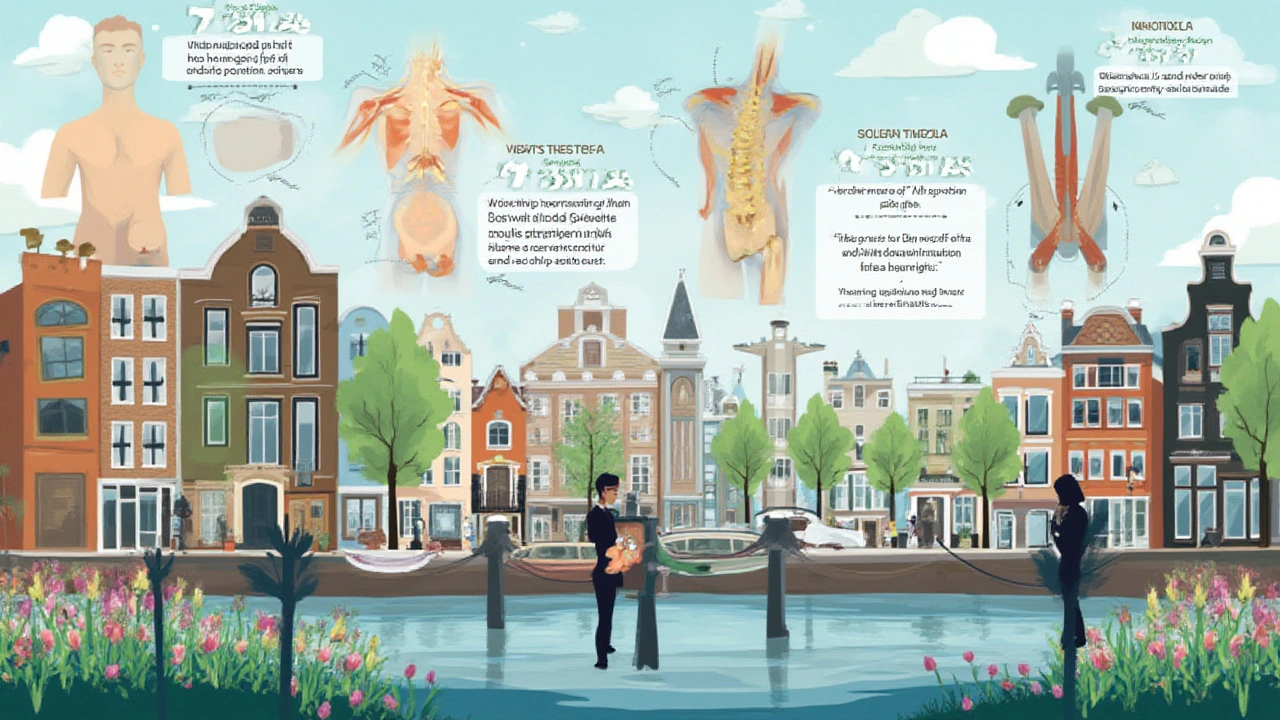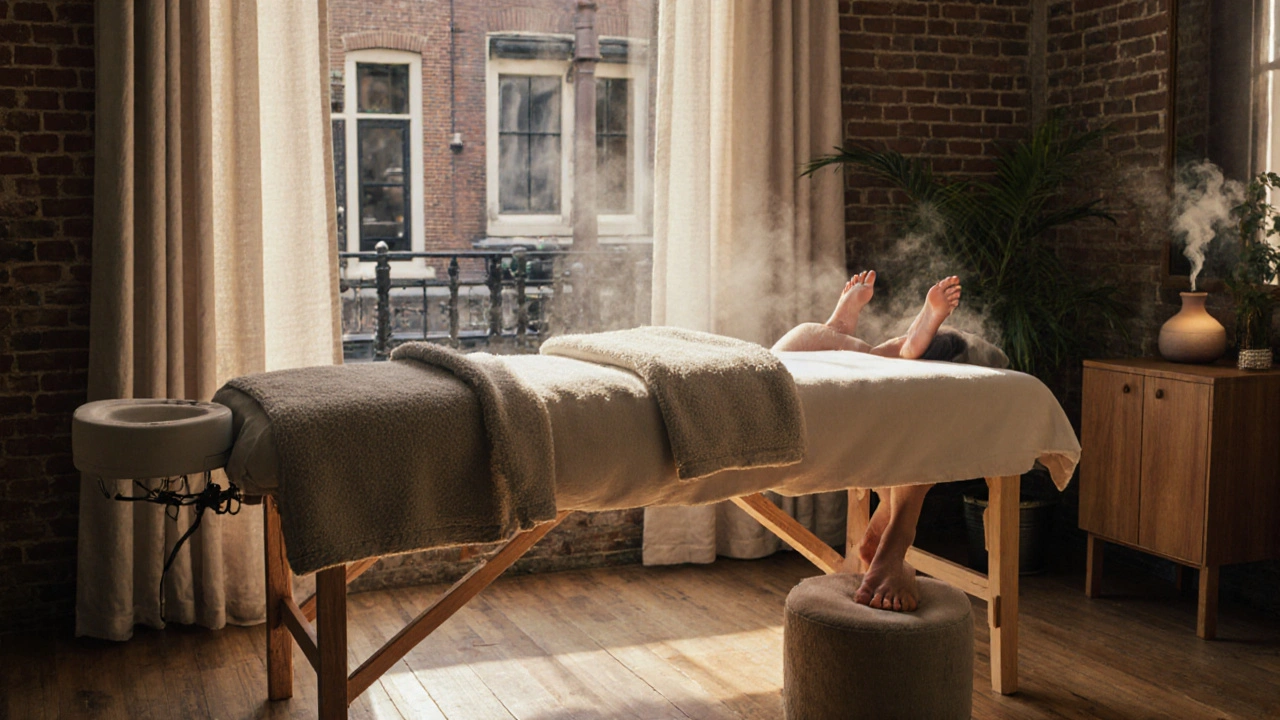Deep Tissue Massage in Amsterdam: Ultimate Office Worker Relief Guide

Ever found yourself rubbing your neck after an endless day behind the laptop, wishing you could just press an “undo” button on all that tension? If you sit at a desk for hours—and let’s be honest, most of us do—deep tissue massage feels less like a luxury, more like pure necessity. Studies have shown that Dutch office workers spend an average of 7.2 hours a day sitting at desks, and it’s not just bad for your posture—it wreaks havoc on your back, neck, and even your mood. Here’s the thing: deep tissue massage does more than just knead tired muscles. It reaches those stubborn knots, the ones that feel like they’re welded under your shoulder blades. If your idea of relaxation has turned into scrolling Instagram with one hand while the other cradles your achy neck, you’re in the right place. We’re diving head-first into how deep tissue massage is the perfect ticket to real relief for anyone glued to their office chair.
Key Points
- Deep tissue massage targets chronic muscle problems, especially common among office workers stuck at desks.
- It uses firm pressure to break up tension and knots in deeper muscle layers, giving long-lasting symptom relief.
- Most Amsterdam clinics offer deep tissue massage, with skilled therapists familiar with the unique needs of office professionals.
- Expect to experience better posture, less pain, and improved focus after regular sessions.
- Prices in Amsterdam range from €60-€120 per hour, with easy online booking options available citywide.
Direct Answer
If you’re sitting for hours, battling stiffness, or dealing with tension headaches, a deep tissue massage can make all the difference. It’s not a spa day with tinkling bells and aromatherapy—it’s about real, focused relief that works muscles deep below the surface. Most people who try it notice improved range of motion, less pain, and better sleep. Amsterdam is packed with talented massage therapists who specialize in this technique. Booking is as easy as checking your calendar and clicking a button online. If you work in an office and want to say goodbye to tight shoulders and tired backs, deep tissue massage should be your go-to solution.
Comprehensive Guide to Deep Tissue Massage: The Perfect Solution for Office Workers
Office jobs sound cushy until you realize your body’s quietly plotting revenge one knot at a time. The human body wasn’t designed to be folded into a chair for 8 hours straight. Yet here we are, tapping away at keyboards and ignoring the slow build-up of tension from hours of awkward posture. Sitting all day slows blood flow, compresses your spine, and shortens your hip flexors. Shoulder and neck tightness practically come with the job. Sure, you can stretch at your desk, but those deep knots? They usually laugh at a quick forward bend.
Deep tissue massage goes well beyond a gentle rub or relaxation massage. The therapist uses sustained, strong pressure and slow, deliberate strokes that get right into the thick of contracted muscles and fascia (that’s the dense, web-like tissue that holds everything together inside you). If you’ve ever had a tension headache melt away after a massage or walked out feeling lighter and taller, you’ve already tasted just a bit of what this treatment can do. The key difference? The intensity. Deep tissue really means deep. The therapist might use fingertips, knuckles, elbows, or even forearms to sink right into those stubborn spots where tension loves to hide. Personal stories pop up everywhere: a copywriter with chronic wrist pain regains full movement, a startup founder finds their first headache-free week in years, or an HR manager finally ditches the “computer hunch.”
The buzz about deep tissue massage isn’t just hype. Dutch health insurers even recognize medical massage in some coverage packages, and Dutch research from 2023 found that regular sessions can cut reported pain levels in office workers by nearly 40%. Who wouldn’t want that? It doesn’t stop at pain, either. A well-targeted massage can lower your stress hormones, help you sleep deeper, and boost your mood, slashing your risk of burnout. In my Amsterdam neighborhood, people swap tips on the best masseurs the way others trade brunch recommendations.
The setting matters, too. Some hideaways have candlelit rooms, soft music and heated tables, while others resemble straight-up sports clinics with no-nonsense professionalism. It all comes down to preference, but the results speak for themselves. One teacher told me she schedules her deep tissue appointments on Fridays, walks out like a new person, and breezes into the weekend without that nagging, heavy feeling in her back. Amsterdam, with its cycling commutes and digital workforce, is practically built for this style of therapy. After all, relief shouldn’t just be for people nursing sports injuries or training for marathons. Your desk job is enough of a physical test, trust me.
Definition and Context
So, what is a deep tissue massage, precisely? It’s a style of therapeutic bodywork that literally focuses on “deep” muscle structures. Instead of gliding over the surface, therapists really get into the heart of tense tissue. They use very specific, targeted strokes and sustained pressure—think of it as a detective hunt for hidden knots.
This isn’t just a stronger Swedish massage. Where a classic Swedish massage uses lighter, relaxing strokes, deep tissue targets knots, adhesions (those stubborn, glue-like muscle bands), and chronic muscle problems that often prompt the body’s natural pain response. Don’t expect tickling touches—therapists press slowly and steadily, using elbows, fists, or even special massage tools to reach buried tension. Unlike some lighter massages where you might zone out completely, you’ll feel the pressure here—and often some good “hurts so good” pain.
But pain tolerance is individual, and everyone’s got preferences. A quality deep tissue therapist starts slow, checks in with you, and adjusts pressure accordingly, making your session a tailored experience. It’s all about dissolving tension—not hurting you. For office workers, the classic trouble zones are the shoulders, neck, upper back, and even the forearms or hands. Muscles in these areas grip tight from mouse use, typing, or peering at screens all day.
Then there’s fascia. Think of it like a clingfilm or saran wrap covering and connecting everything beneath your skin. With stress or inactivity, fascia thickens and shortens—meaning less flexibility and more discomfort. Deep tissue massage addresses both muscle fibers and fascia adhesions, giving you back range of motion and comfort. Often, you’ll hear crackling sounds or feel that signature “release” as those stuck layers finally give way.
Amsterdam is a hotspot for this style, with most spas and clinics offering versions of deep tissue massage tailored to modern, sedentary life. Many therapists have extra training in anatomy or even sports medicine, because office-related tension isn’t so different from what cyclists or runners experience. That’s why these sessions are recommended for everyone from busy tech workers in the Zuidas district to art students bent over sketchbooks in De Pijp.
Why does it matter? Without intervention, desk-life body issues pile up. They can trigger chronic headaches, jaw pain (from clenching or stress), and recurring back pain that no amount of yoga or posture apps can touch. Deep tissue massage gets right to the source—and done regularly, it can even prevent new knots from forming. Dutch physiotherapists often refer office workers for deep tissue work, especially when aches and pains keep returning. At this point, deep tissue is as normal in Amsterdam as a weekly cycling ride or grocery run—just much, much better for your body.
Benefits of Deep Tissue Massage for Office Workers
The magic happens when you get off the table, and not just because you finally feel taller. Regular deep tissue massage changes your body’s stress response, so you’re not just chasing one-off relief but building real resilience. Forget about popping paracetamol after a long meeting. A 2022 Amsterdam medical survey showed that 69% of office workers who received monthly deep tissue sessions reduced their use of painkillers by at least half. That’s real impact.
First up? Pain release is the headline. Think chronic back aches, stiff necks, or even sciatica symptoms. Those recurring feelings of tightness and dull pain? Deep tissue targets the root and actually breaks up adhesions that block healthy blood flow. Improved circulation helps nutrients shuttle faster to tired muscles and speeds up healing. It means less fatigue, more flexibility, and sharper focus. Ever noticed how much easier it is to pay attention when your body doesn’t hurt?
Deep tissue is a secret hack for posture, too. Most desk work turns us into human question marks—rounded shoulders, slumped spine, tense jaw, and rolled-in hips. Massage resets these patterns, lengthening muscle fibers and teaching your body what “neutral” should actually feel like. The result? You’ll sit (and stand) taller, and your body will need far less conscious correction throughout the day.
That’s not the end of it. Deep tissue massage can also lower blood pressure and promote deeper, more restorative sleep. With each session, stress hormones like cortisol drop, while feel-good chemicals like serotonin rise. Don’t be surprised if you walk out of your appointment feeling like you just hit “restart” on your whole nervous system.
For those wrestling with recurring headaches or carpal tunnel symptoms, deep tissue massage can be a real lifeline. Releasing tension along the back, neck, and arms often leads to fewer migraines and less tingling or numbness in your hands. If you’re dragging through the 3 p.m. slump every day, consider that your circulation and breathing just aren’t optimal because of muscle tightness. Fix the knots, and you’ll notice your whole energy cycle improves.
Check out this breakdown of reported benefits among Amsterdam office workers who got regular deep tissue massages:
| Reported Improvement | Monthly DTM (Deep Tissue Massage) | No Regular Massage |
|---|---|---|
| Back/Neck Pain Relief | 82% | 41% |
| Better Sleep Quality | 67% | 31% |
| Reduced Stress Symptoms | 77% | 38% |
| Improved Posture | 59% | 19% |
| Better Focus at Work | 62% | 25% |
So, if you feel like your job is grinding down your body, this is your cheat code. Of course, massage isn’t magic overnight, but stacked up over time? The results are hard to ignore. That’s why more Amsterdam offices are even partnering with therapists for in-house wellness programs. Keeping a pain-free, alert team is just good business (and feels amazing for everyone involved).
Types of Deep Tissue Massage Available in Amsterdam
Amsterdam loves choice, and that’s totally true when it comes to deep tissue massage. While the core technique stays the same—firm pressure, slow strokes—you’ll see all sorts of variations depending on where you go and what your body needs.
Classic Deep Tissue Massage is the go-to for most office workers. The therapist zeroes in on your problem spots—upper back, shoulders, neck, and even wrists or forearms. Sessions last anywhere from 30 minutes (for a lunchtime tune-up) all the way to 90 minutes if you really want a full reset. Some therapists mix in gentle stretches or joint mobilization for additional relief.
Sports Deep Tissue Massage is tailored for those who stay active after work (yes, the cycling commuters and joggers are included!). These specialists combine myofascial release (a technique targeting the connective tissue) with muscle fiber stripping. This approach is great if your soreness isn’t just from sitting, but also from weekend bootcamps or races along the Amstel.
Trigger Point Therapy is a variation where the therapist finds and holds pressure on small, hyper-sensitive spots in your muscles—think of it like pressing “pause” on a knot until it lets go. This is perfect for anyone with those tiny, nagging pain points that don’t disappear after a general massage.
Another favorite in my neighborhood is Combo Sessions—deep tissue massage blended with relaxation elements, like breathing guidance or heated packs. These sessions bridge the gap for anyone who wants results but also values a touch of zen. Some holistic centers even offer deep tissue with aromatherapy add-ons or, occasionally, with cupping to suck away muscle tightness (if you’re into that sort of thing).
For the eco-conscious, Amsterdam has multiple locations where therapists use organic, vegan massage waxes, so you're not coating your skin with synthetic junk. There’s truly something for everyone here, whether you want to go deep or simply dip your toe in to see how your body responds.
Looking for the most reputable spots? Neighborhoods like De Pijp, Jordaan, and the Zuidas are packed with high-quality clinics and independent therapists. You’ll even spot some pop-up wellness events in co-working spaces and busy office towers. Most websites have therapist bios highlighting their specialty areas, so you can find someone who’s tackled problems just like yours.

How to Find Deep Tissue Massage Services in Amsterdam
So, where do you track down the perfect deep tissue specialist in Amsterdam? With a ton of options, it’s easier (and more fun) than scrolling endless office memes. First, start with your immediate area. Many expat Facebook groups or neighborhood “WhatsApp Buurt” chats are filled with recommendations for therapists who understand office-driven aches. If you work in Zuid, hit the Zuidas for modern clinics. Near Central Station, you’ll find hidden gems tucked between cafes and shops.
Google Maps is your best friend. Just type in “deep tissue massage near me,” and you’ll see dozens of highly-rated clinics popping up. Filter by reviews—look for therapists who specifically mention success with office workers, repetitive strain, or stress relief. If you see a place with consistent 5-star ratings for technique (not just ambiance), that’s usually a safe bet.
Most places support online booking, so there’s no need for awkward phone calls or Dutch-language stress. Simply pick a slot, pay a deposit (if needed), and you’re all set. For the best chance at prime times (think lunch breaks or after 5 p.m.), try booking at least a week ahead. If you’re unsure, many clinics let you send a message to discuss your symptoms, so you get matched with the best therapist for your needs.
Some handy tips: Ask if the therapist is registered with the Nederlands Genootschap voor Sportmassage (NGS) or another reputable Dutch massage association. Those with official registration often have additional training in anatomy and offer a higher level of expertise—especially useful if you need very targeted work for chronic pain or injury prevention.
If you’re new to deep tissue, start with a 60-minute session and bring a list (mental or literal) of your main complaints. This helps the therapist focus directly on the zones that bother you the most. Many clinics offer package deals or discounts if you book a series in advance—perfect if you know you’ll need regular relief.
For those who prefer visual aids, here’s a sample map layout that showcases some of Amsterdam’s busiest office districts and popular massage clinics:
- Zuidas: Packed with modern clinics inside business towers; many cater directly to finance and tech workers.
- De Pijp: Home to boutique wellness studios and holistic centers; great for creative professionals.
- Jordaan: Cozy, independent massage spaces; ideal for freelancers and home-based workers.
- Amsterdam Centrum: A mix of quick-fix pop-ups and longer sessions; easy access for anyone near Central Station.
If you work at a co-working space, check the amenities—many now offer in-house massage therapists by appointment. If you’re lucky, your employer may even subsidize these sessions as part of workplace wellness perks.
What to Expect During a Session
Walking into your first appointment can feel a bit awkward, but therapists in Amsterdam are totally used to first-timers (and office folks who flinch at firm pressure). You’ll fill in a quick health questionnaire—this helps the therapist understand any injuries or problem zones. The therapist will then ask about your daily routine and which areas feel the worst. Don’t be shy here—the more honest you are, the better they can help.
You’ll undress to your comfort level (typically underwear), and the therapist drapes you with towels for privacy. Deep tissue massage usually starts with lighter strokes to warm up the muscles. Gradually, the therapist increases pressure, focusing in on knots, tight bands, or trigger points. Some therapists use massage oil to reduce friction and glide smoothly; others use wax or even dry techniques for better grip.
It’s totally normal to feel discomfort—often described as “good pain.” You should always be able to breathe easily, though. If the pressure is too much, just say so. The therapist will adjust instantly. Expect them to check in a few times, especially if they notice you tensing up. Communication is the secret sauce here.
Sessions can focus on anything from just your back and neck to the full body (think legs, glutes, and arms). If you get tension headaches, don’t be surprised if they work gently around your jaw and scalp, too. Expect some clicking or popping sensations as muscle fibers and fascia release. Kneading, stripping, circular movements, and pressure-point holds are all fair game.
After your session, you’ll probably feel both super relaxed and slightly sore—kind of like a “workout afterglow.” Many people report immediate relief, but some muscle tenderness can last up to two days (this is just your body adjusting). Drink lots of water to flush out byproducts, and don’t book any heavy exercise or intense meetings right after your massage. Some therapists recommend a warm shower afterwards, to further release tension.
A little tip: Plan your appointment later in the day if possible, so you can really enjoy the post-massage glow at home. If you’re nervous, ask your therapist to walk you through each step before they begin—it’s part of their job to help you feel safe and cared for.
Pricing and Booking
Prices for deep tissue massage in Amsterdam usually start around €60 for a basic 45-minute session, scaling up to €120 for a more intensive 90-minute experience. The average for a solid, professional 60-minute treatment sits right at €80-€90. Package deals often knock around 10-20% off if you commit to a regular schedule—perfect for keeping office-related aches at bay.
Make sure to check if your health insurer covers part of the costs. Some supplementary Dutch insurance plans will reimburse sessions from registered therapists, saving you a hefty chunk if you need regular massages for chronic pain or prevention.
Booking couldn’t be easier. Most clinics use simple online calendars where you pick your preferred therapist, session length, and a time that fits your workday. A few clinics have dedicated WhatsApp booking, so you can arrange appointments on the fly—handy for busy weeks. If you prefer, you can always call (but honestly, online is the stress-free route for most Amsterdam workers!).
Last-minute openings are sometimes listed on Instagram, so if you have flexibility, keep an eye out for discounted rush slots. Just be quick—they disappear fast. Some companies also bring therapists to offices for group sessions or wellness days, so ask your HR manager if you think others could benefit, too.
Safety Tips
Deep tissue massage is safe for most people, but you want to make sure your experience is not just relaxing, but professional and healthy. Always inform your therapist about any health conditions, recent injuries, or ongoing medical treatments. If you’ve recently had surgery, have varicose veins, or are pregnant, let them know so they can adapt the treatment. Likewise, clarify any allergies if oils or waxes are used.
It’s okay to ask about your therapist’s experience and training—preferably pick someone registered with well-known Dutch bodies. Check for valid licenses and positive reviews, especially if you’re trying a new clinic. If anything feels off or painful in a bad way, speak up immediately. Good therapists will always adjust their approach.
If you feel dizzy or unwell during or after the session, let your therapist know and sit quietly for a few minutes before leaving. Avoid heavy meals or alcohol right before your appointment, as these can sometimes amplify discomfort. Follow your therapist’s aftercare advice—this usually includes drinking water and taking it easy.
Deep tissue massage is a powerful tool, but it’s extra effective when paired with good daily posture, regular movement, and plenty of hydration. Consider stretching or mobility exercises between sessions to maintain the benefits.
Comparison Table: Deep Tissue Massage vs. Swedish Massage in Amsterdam
| Feature | Deep Tissue Massage | Swedish Massage |
|---|---|---|
| Main Focus | Chronic pain & muscle knots | Relaxation & stress relief |
| Pressure Level | Firm to very strong | Light to moderate |
| Best For | Office workers, athletes, injury recovery | First-timers, stress reduction, lighter aches |
| Techniques Used | Slow, targeted, deep strokes. Trigger point work. | Long, sweeping, gliding strokes |
| Typical Soreness Afterward | Mild to moderate (1-2 days) | Very mild or none |
| Availability in Amsterdam | Widespread, popular in offices & clinics | Highly common, standard at most spas |
FAQ: Your Questions About Deep Tissue Massage Answered
- Does deep tissue massage hurt? You’ll feel firm pressure and a little discomfort in tense spots, but it shouldn’t be truly painful. Talk to your therapist if you need the pressure adjusted.
- How often should office workers get a deep tissue massage? Monthly sessions help most people stay ahead of chronic pain, but if you’ve got a serious issue or high stress, every 2 weeks is even better.
- Can I get deep tissue massage while pregnant? Some clinics offer specialized “prenatal massage,” but deep tissue as described here is usually not recommended during pregnancy without a trained therapist.
- Is massage covered by insurance? Some Dutch health insurance providers reimburse registered therapists. Check your plan’s supplementary care section or ask your massage clinic about paperwork.
- Will I be sore after my session? It’s common to feel mild muscle tenderness for a day or two—just like after a good workout. This fades quickly and is usually followed by lasting relief.
- How do I prepare for my first appointment? Wear comfy clothes, avoid big meals beforehand, and arrive ten minutes early to fill out paperwork and relax.
- Is tipping expected in Amsterdam? Not usually, but if you loved your therapist, a small cash thank-you is always appreciated!

Ready to Book Your Deep Tissue Massage?
Your body’s not meant to grind away at a desk all day without relief. If you’re ready to ditch stubborn knots and reclaim comfort, deep tissue massage in Amsterdam is just a click away. Treat yourself—you honestly deserve it.


